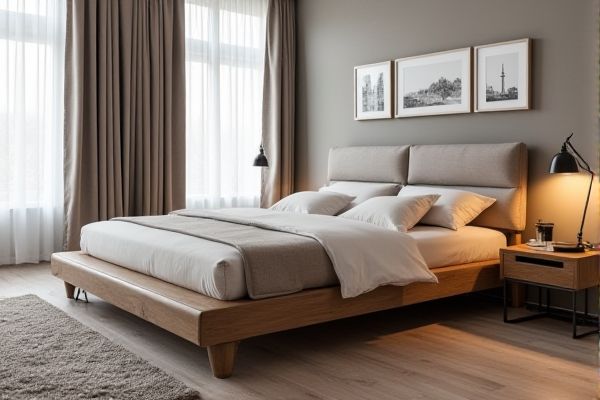
Modular bed frames offer customizable, easy-to-assemble designs that adapt to your space and style preferences, unlike traditional bed frames which are typically fixed and bulky. Explore the rest of the article to discover which bed frame suits your needs best.
Table of Comparison
| Feature | Modular Bed Frame | Traditional Bed Frame |
|---|---|---|
| Design | Customizable, multiple components | Fixed structure, pre-assembled |
| Assembly | Easy to assemble and disassemble | Complex assembly; often permanent |
| Portability | Highly portable, ideal for moving | Heavy and bulky |
| Adjustability | Often adjustable in size and height | Non-adjustable |
| Durability | Depends on materials; usually sturdy | Typically long-lasting and solid |
| Cost | Moderate to high depending on parts | Varies from low to high |
| Customization | High customization options | Limited customization |
| Maintenance | Easy to replace parts | More difficult to repair |
Introduction to Bed Frame Types
Modular bed frames offer customizable configurations with adjustable components, providing enhanced versatility compared to traditional bed frames that feature fixed, often solid wood or metal structures. These frames cater to evolving needs, allowing easy assembly, disassembly, and integration with storage or seating elements, which is less common in traditional designs. Durability and aesthetics vary, with traditional frames emphasizing classic craftsmanship and modular frames prioritizing functional adaptability.
What is a Modular Bed Frame?
A modular bed frame is a customizable and easily adjustable furniture system composed of separate components that can be assembled or reconfigured to fit different mattress sizes and room layouts. Unlike traditional bed frames, which are typically fixed in size and design, modular bed frames offer enhanced flexibility, making them ideal for evolving needs and small spaces. Your choice of a modular bed frame supports versatility and convenience, often featuring lightweight materials and tool-free assembly.
Understanding Traditional Bed Frames
Traditional bed frames feature a sturdy metal or wooden structure designed to support a mattress and box spring, typically including four legs and side rails for stability. These frames often require tools for assembly and lack the flexibility to adjust size or configuration. Understanding your traditional bed frame's fixed design helps determine compatibility with various mattress types and room layouts.
Key Features Comparison
Modular bed frames offer customizable configurations with adjustable sizes and additional storage options, contrasting with traditional bed frames that provide fixed dimensions and simpler designs. Constructed from lightweight materials, modular frames emphasize easy assembly and disassembly, while traditional frames often utilize solid wood or metal for enhanced durability. The modular design supports versatility in bedroom layouts, whereas traditional frames prioritize classic aesthetics and long-term stability.
Assembly and Installation
Modular bed frames offer simplified assembly with lightweight, interlocking components that require minimal tools, making installation faster and more convenient compared to traditional bed frames. Traditional bed frames often involve complex hardware and heavy parts, necessitating extra time and effort to securely assemble and adjust. You'll find modular designs ideal for easy setup, frequent moves, or space customization without compromising stability.
Customization and Flexibility
Modular bed frames offer superior customization and flexibility compared to traditional bed frames, allowing you to easily adjust size, height, and configuration to fit your room and mattress preferences. These frames often feature interchangeable components, making it simple to upgrade or reconfigure without replacing the entire bed structure. Your ability to personalize a modular bed frame makes it ideal for evolving needs, unlike rigid traditional bed frames that limit adaptability.
Durability and Maintenance
Modular bed frames offer enhanced durability through their robust design, utilizing high-quality metal or hardwood components that resist wear and tear better than many traditional wooden bed frames. Maintenance of modular frames is simplified due to their easily replaceable parts, allowing users to swap out broken or worn sections without replacing the entire frame. Traditional bed frames often require more frequent repairs and are prone to issues like joint loosening or wood warping, which can compromise structural integrity over time.
Aesthetics and Design Options
Modular bed frames offer customizable aesthetics with interchangeable components that adapt to various interior styles, enhancing versatility and personal expression. Traditional bed frames typically feature fixed designs ranging from classic to modern, limiting customization but often providing timeless appeal. The modular approach supports innovative materials and configurations that cater to contemporary design trends, while traditional frames emphasize craftsmanship and durability in established styles.
Cost and Value Analysis
Modular bed frames typically offer a more cost-effective solution with flexible pricing options depending on customization and materials, making them ideal for budget-conscious buyers seeking adaptable furniture. Traditional bed frames often come with a higher initial cost but provide durable construction and classic designs that may add long-term value to your bedroom setup. You can maximize value by balancing upfront investment and future adaptability when choosing between modular and traditional bed frames.
Choosing the Right Bed Frame for Your Needs
Modular bed frames offer customizable options with adjustable sizes and built-in storage, making them ideal for small spaces and frequent movers. Traditional bed frames provide sturdy, classic designs with fixed dimensions, suited for those prioritizing durability and aesthetic consistency. Evaluating your space constraints, mobility needs, and design preferences ensures you choose the right bed frame aligning with your lifestyle.
 homyna.com
homyna.com